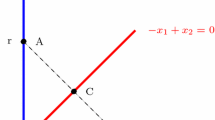Abstract
In this note, we explore the implications of a result that suggests that the duality gap caused by a Lagrangian relaxation of the nonanticipativity constraints in a stochastic mixed integer (binary) program diminishes as the number of scenarios increases. By way of an example, we illustrate that this is not the case. In general, the duality gap remains bounded away from zero.
Similar content being viewed by others
References
Bertsekas, D.P. (1982), Constrained Optimization and Lagrange Multiplier Methods, Academic Press, New York.
Birge, J.R. and Dempster, M.A.H. (1996), Stochastic programming approaches to stochastic scheduling, J. Global Optimization 9: 417-451.
Carøe, C. (1998), Decomposition in Stochastic Integer Programming, Ph.D. thesis, Institute for Mathematical Sciences, Dept. of Operations Research, University of Copenhagen, Denmark.
Carøe, C. and Schultz, R. (1998), Dual decomposition in stochastic integer programming, Operations Research Letters 24: 37-45.
Dentcheva, D. and Römisch, W. (1998), Optimal power generation under uncertainty via stochastic programming. Preprint 96-35, Humboldt-Universtät Berlin, Institut für Mathematic, 1996, to appear in K. Marty and P. Kall (eds.), Stochastic Programming Methods and Technical Applications, Lecture Notes in Economics and Mathematical Systems 458, Springer, Berlin.
Dror, M., Laporte, D. and Trudeau, P. (1989), Vehicle routing with stochastic demands: properties and solution frameworks. Transportation Science 23(3): 166-176.
Takriti, S., Birge, J.R. and Long, E. (1996), A stochastic model for the unit commitment problem, IEEE Transactions on Power Systems 11: 1497-1508.
Author information
Authors and Affiliations
Rights and permissions
About this article
Cite this article
Sen, S., Higle, J.L. & Birge, J.R. Duality Gaps in Stochastic Integer Programming. Journal of Global Optimization 18, 189–194 (2000). https://doi.org/10.1023/A:1008314824754
Issue Date:
DOI: https://doi.org/10.1023/A:1008314824754




